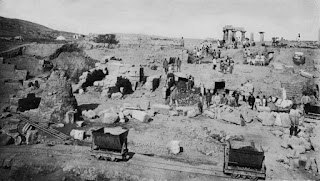Terracotta head of a woman
Period:HellenisticDate:3rd–2nd century B.C.Culture:Greek, South Italian, TarentineMedium:TerracottaDimensions:H. 10 1/2 in. (26.7 cm)Classification:TerracottasCredit Line:Rogers Fund, 1923Accession Number:23.160.95
Since fine, hard stone such as marble was not readily available, Tarentine artists used terracotta for large-scale figures of high quality. The work to which this extraordinary head originally belonged may have been associated with a goddess, perhaps Aphrodite. Among the thousands of clay vases and figures found at Tarentum, subjects pertaining to the life of women, and specifically marriage, are prevalent.
http://www.metmuseum.org/art/collection/search/251428












































